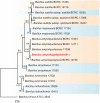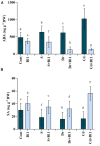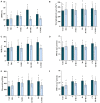Rhizospheric Bacillus amyloliquefaciens Protects Capsicum annuum cv. Geumsugangsan From Multiple Abiotic Stresses via Multifarious Plant Growth-Promoting Attributes
- PMID: 34113368
- PMCID: PMC8185346
- DOI: 10.3389/fpls.2021.669693
Rhizospheric Bacillus amyloliquefaciens Protects Capsicum annuum cv. Geumsugangsan From Multiple Abiotic Stresses via Multifarious Plant Growth-Promoting Attributes
Abstract
Plant growth-promoting rhizobacteria (PGPR) are beneficial microorganisms that can be utilized to improve plant responses against biotic and abiotic stresses. In this study, we investigated whether PGPR (Bacillus amyloliquefaciens) isolated from the endorhizosphere of Sasamorpha borealis have the potential to sustain pepper growth under drought, salinity, and heavy metal stresses. The bacterial strain was determined based on 16S rDNA and gyrB gene sequencing and characterized based on the following biochemical traits: nitrogen fixation; 1-aminocyclopropane-1-carboxylate deaminase activity; indole acetic acid production; inorganic phosphate, potassium, zinc, and silicon solubilization; and siderophore production. Various abiotic stresses were applied to 28-day-old pepper seedlings, and the influence of the PGPR strain on pepper seedling growth under these stress conditions was evaluated. The application of PGPR improved survival of the inoculated pepper plants under stress conditions, which was reflected by higher seedling growth rate and improved physiochemical traits. The PGPR-treated plants maintained high chlorophyll, salicylic acid, sugar, amino acid, and proline contents and showed low lipid metabolism, abscisic acid, protein, hydrogen peroxide contents, and antioxidant activities under stress conditions. Gene expression studies confirmed our physiological and biochemical findings. PGPR inoculation led to enhanced expression of XTH genes and reduced expression of WRKY2, BI-1, PTI1, and binding immunoglobulin protein (BiP) genes. We conclude that the PGPR strain described in this study has great potential for use in the phytoremediation of heavy metals and for enhancing pepper plant productivity under stress conditions, particularly those involving salinity and drought.
Keywords: 1-aminocyclopropane-1-carboxylate deaminase; drought; endophyte; pepper; phytoremediation; plant growth-promoting rhizobacteria; salinity.
Copyright © 2021 Kazerooni, Maharachchikumbura, Adhikari, Al-Sadi, Kang, Kim and Lee.
Conflict of interest statement
The authors declare that the research was conducted in the absence of any commercial or financial relationships that could be construed as a potential conflict of interest.
Figures





Similar articles
-
Plant growth-promoting rhizobacterium Bacillus megaterium modulates the expression of antioxidant-related and drought-responsive genes to protect rice (Oryza sativa L.) from drought.Front Microbiol. 2024 Aug 21;15:1430546. doi: 10.3389/fmicb.2024.1430546. eCollection 2024. Front Microbiol. 2024. PMID: 39234545 Free PMC article.
-
Isolation and Characterization of Halotolerant Plant Growth Promoting Rhizobacteria From Durum Wheat (Triticum turgidum subsp. durum) Cultivated in Saline Areas of the Dead Sea Region.Front Microbiol. 2019 Jul 23;10:1639. doi: 10.3389/fmicb.2019.01639. eCollection 2019. Front Microbiol. 2019. PMID: 31396175 Free PMC article.
-
Plant growth promotion and alleviation of salinity stress in Capsicum annuum L. by Bacillus isolated from saline soil in Xinjiang.Ecotoxicol Environ Saf. 2018 Nov 30;164:520-529. doi: 10.1016/j.ecoenv.2018.08.070. Epub 2018 Aug 24. Ecotoxicol Environ Saf. 2018. PMID: 30149350
-
Perspective of plant growth promoting rhizobacteria (PGPR) containing ACC deaminase in stress agriculture.J Ind Microbiol Biotechnol. 2007 Oct;34(10):635-48. doi: 10.1007/s10295-007-0240-6. Epub 2007 Jul 31. J Ind Microbiol Biotechnol. 2007. PMID: 17665234 Review.
-
Use of plant growth promoting rhizobacteria (PGPRs) with multiple plant growth promoting traits in stress agriculture: Action mechanisms and future prospects.Ecotoxicol Environ Saf. 2018 Jul 30;156:225-246. doi: 10.1016/j.ecoenv.2018.03.013. Epub 2018 Mar 20. Ecotoxicol Environ Saf. 2018. PMID: 29554608 Review.
Cited by
-
Insight into the Mechanism of Salt-Induced Oxidative Stress Tolerance in Soybean by the Application of Bacillus subtilis: Coordinated Actions of Osmoregulation, Ion Homeostasis, Antioxidant Defense, and Methylglyoxal Detoxification.Antioxidants (Basel). 2022 Sep 20;11(10):1856. doi: 10.3390/antiox11101856. Antioxidants (Basel). 2022. PMID: 36290578 Free PMC article.
-
Delineation of mechanistic approaches of rhizosphere microorganisms facilitated plant health and resilience under challenging conditions.3 Biotech. 2022 Mar;12(3):57. doi: 10.1007/s13205-022-03115-4. Epub 2022 Feb 4. 3 Biotech. 2022. PMID: 35186654 Free PMC article. Review.
-
Effects of Abiotic Stress on Soil Microbiome.Int J Mol Sci. 2021 Aug 21;22(16):9036. doi: 10.3390/ijms22169036. Int J Mol Sci. 2021. PMID: 34445742 Free PMC article. Review.
-
Physiological and molecular insight of microbial biostimulants for sustainable agriculture.Front Plant Sci. 2023 Jan 30;14:1041413. doi: 10.3389/fpls.2023.1041413. eCollection 2023. Front Plant Sci. 2023. PMID: 36794211 Free PMC article. Review.
-
Characterization and Functional Analysis of GhNAC82, A NAM Domain Gene, Coordinates the Leaf Senescence in Upland Cotton (Gossypium hirsutum L.).Plants (Basel). 2022 Jun 1;11(11):1491. doi: 10.3390/plants11111491. Plants (Basel). 2022. PMID: 35684264 Free PMC article.
References
-
- Agarwal S., Pandey V. (2004). Antioxidant enzyme responses to NaCl stress in Cassia angustifolia. Biol. Plant. 48 555–560. 10.1023/B:BIOP.0000047152.07878.e7 - DOI
-
- Ahaotu I., Anyogu A., Njoku O. H., Odu N. N., Sutherland J. P., Ouoba L. I. I. (2013). Molecular identification and safety of Bacillus species involved in the fermentation of African oil beans (Pentaclethra macrophylla Benth) for production of Ugba. Int. J. Food Microbiol. 162 95–104. 10.1016/j.ijfoodmicro.2013.01.001 - DOI - PubMed
-
- Albdaiwi R. N., Khyami-Horani H., Ayad J. Y., Alananbeh K. M., Al-Sayaydeh R. (2019). Isolation and characterization of halotolerant plant growth promoting rhizobacteria from durum wheat (Triticum turgidum subsp. durum) cultivated in saline areas of the dead sea region. Front. Microbiol. 10:1639. 10.3389/fmicb.2019.01639 - DOI - PMC - PubMed
-
- Alexander D., Zuberer D. (1991). Use of chrome azurol S reagents to evaluate siderophore production by rhizosphere bacteria. Biol. Fertil. Soils 12 39–45. 10.1007/bf00369386 - DOI
-
- Ali S. Z., Sandhya V., Rao L. V. (2014). Isolation and characterization of drought-tolerant ACC deaminase and exopolysaccharide-producing fluorescent Pseudomonas sp. Ann. Microbiol. 64 493–502. 10.1007/s13213-013-0680-3 - DOI
LinkOut - more resources
Full Text Sources

